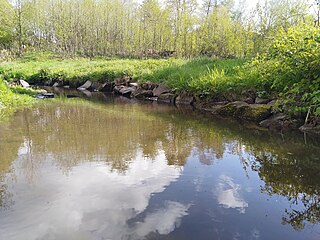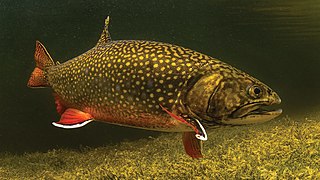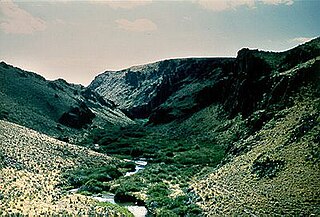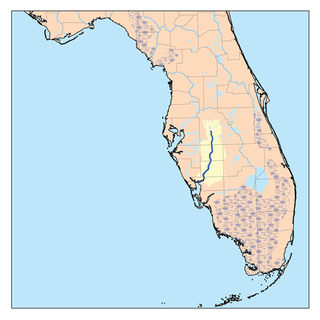
An aquifer is an underground layer of water-bearing permeable rock, rock fractures or unconsolidated materials. Groundwater from aquifers can be extracted using a water well. The study of water flow in aquifers and the characterization of aquifers is called hydrogeology. Related terms include aquitard, which is a bed of low permeability along an aquifer, and aquiclude, which is a solid, impermeable area underlying or overlying an aquifer, the pressure of which could create a confined aquifer.

The water table is the upper surface of the zone of saturation. The zone of saturation is where the pores and fractures of the ground are saturated with water. It can also be simply explained as, the upper level, below which the ground is saturated.

Fly fishing is an angling method that uses a light-weight lure—called an artificial fly—to catch fish. The fly is cast using a fly rod, reel, and specialized weighted line. The light weight requires casting techniques significantly different from other forms of casting. The flies may resemble natural invertebrates, baitfish, or other food organisms.

A spring is a point at which water flows from an aquifer to the Earth's surface. It is a component of the hydrosphere.

The Deschutes River in central Oregon is a major tributary of the Columbia River. The river provides much of the drainage on the eastern side of the Cascade Range in Oregon, gathering many of the tributaries that descend from the drier, eastern flank of the mountains. The Deschutes provided an important route to and from the Columbia for Native Americans for thousands of years, and then in the 19th century for pioneers on the Oregon Trail. The river flows mostly through rugged and arid country, and its valley provides a cultural heart for central Oregon. Today the river supplies water for irrigation and is popular in the summer for whitewater rafting and fishing.

The Kern River, originally Rio de San Felipe, later La Porciuncula, is a river in the U.S. state of California, approximately 165 miles (270 km) long. It drains an area of the southern Sierra Nevada mountains northeast of Bakersfield. Fed by snowmelt near Mount Whitney, the river passes through scenic canyons in the mountains and is a popular destination for whitewater rafting and kayaking. It is the southernmost major river system in the Sierra Nevada, and is the only major river in the Sierra that drains in a southerly direction.

A body of water or waterbody is any significant accumulation of water, generally on a planet's surface. The term most often refers to oceans, seas, and lakes, but it includes smaller pools of water such as ponds, wetlands, or more rarely, puddles. A body of water does not have to be still or contained; rivers, streams, canals, and other geographical features where water moves from one place to another are also considered bodies of water.

The brook trout is a species of freshwater fish in the char genus Salvelinus of the salmon family Salmonidae. It is native to Eastern North America in the United States and Canada, but has been introduced elsewhere in North America, as well as to Iceland, Europe, and Asia. In parts of its range, it is also known as the eastern brook trout, speckled trout, brook charr, squaretail, or mud trout, among others. A potamodromous population in Lake Superior, as well as an anadromous population in Maine, is known as coaster trout or, simply, as coasters. The brook trout is the state fish of nine U.S. states: Michigan, New Hampshire, New Jersey, New York, North Carolina, Pennsylvania, Vermont, Virginia, and West Virginia, and the Provincial Fish of Nova Scotia in Canada.

Chalk streams are rivers that rise from springs in landscapes with chalk bedrock. Since chalk is permeable, water percolates easily through the ground to the water table and chalk streams therefore receive little surface runoff. As a result, the water in the streams contains little organic matter and sediment and is generally very clear. The beds of the rivers are generally composed of clean, compacted gravel and flints, which are good spawning areas for Salmonidae fish species.

Anchor ice is defined by the World Meteorological Organization as "submerged ice attached or anchored to the bottom, irrespective of the nature of its formation". It may also be called bottom-fast ice. Anchor ice is most commonly observed in fast-flowing rivers during periods of extreme cold, at the mouths of rivers flowing into very cold seawater, in the shallow sub or intertidal during or after storms when the air temperature is below the freezing point of the water, and the subtidal in the Antarctic along ice shelves or near floating glacier tongues, and in shallow lakes.

The Pheasant Tail is a popular nymph imitation used when fly fishing. It is used to mimic a large variety of aquatic insect larvae that many fish including trout feed upon. It is also widely referred to as the Sawyer’s Pheasant Tail, in relation to the original creator of this fly.

A perennial stream or perennial river is a stream or river (channel) which has constant stream throughout the year through parts of its stream bed during years of normal rainfall. In the absence of irregular, prolonged, or extreme drought, a perennial stream is a watercourse, or segment, element, or emerging body of water which continually delivers groundwater. For example, an artificial disruption of stream, variability in flow or stream selection associated with the activity in hydropower installations, shall not affect the measurement. Perennial streams do not consist of stagnant water for the wetlands, reservoirs, and ponds that occur all the period. All other streams, or portions thereof, should be considered seasonal rivers or lakes. The stream can cycle from broken to perpetual through multiple iterations, to intermittent through its mechanism.

Giant Springs is a large first magnitude spring located near Great Falls, Montana and is the central feature of Giant Springs State Park. Its water has a constant temperature of 54 °F (12 °C) and originates from snowmelt in the Little Belt Mountains, 60 miles (97 km) away. According to chlorofluorocarbon dating, the water takes about 3,000 years to travel underground before returning to the surface at the springs.

A seep or flush is a moist or wet place where water, usually groundwater, reaches the earth's surface from an underground aquifer.

A stream is a body of water with surface water flowing within the bed and banks of a channel. The flow of a stream is controlled by three inputs – surface water, subsurface water and groundwater. The surface and subsurface water are highly variable between periods of rainfall. Groundwater, on the other hand, has a relatively constant input and is controlled more by long-term patterns of precipitation. The stream encompasses surface, subsurface and groundwater fluxes that respond to geological, geomorphological, hydrological and biotic controls.

A river is a natural flowing watercourse, usually freshwater, flowing towards an ocean, sea, lake or another river. In some cases a river flows into the ground and becomes dry at the end of its course without reaching another body of water. Small rivers can be referred to using names such as stream, creek, brook, rivulet, and rill. There are no official definitions for the generic term river as applied to geographic features, although in some countries or communities a stream is defined by its size. Many names for small rivers are specific to geographic location; examples are "run" in some parts of the United States, "burn" in Scotland and northeast England, and "beck" in northern England. Sometimes a river is defined as being larger than a creek, but not always: the language is vague.
Freshwater environmental quality parameters are those chemical, physical or biological parameters that can be used to characterise a freshwater body. Because almost all water bodies are dynamic in their composition, the relevant quality parameters are typically expressed as a range of expected concentrations.

Salmon Falls Creek is a tributary of the Snake River, flowing from northern Nevada into Idaho in the United States. Formed in high mountains at the northern edge of the Great Basin, Salmon Falls Creek flows northwards 121 miles (195 km), draining an arid and mountainous basin of 2,103 square miles (5,450 km2). The Salmon Falls Creek valley served as a trade route between the Native American groups of the Snake River Plain and Great Basin. Today, most of its water is used for irrigation.
The Hamza River is an unofficial name for what seems to be a slowly flowing aquifer in Brazil and Peru, approximately 6,000 kilometres (3,700 mi) long at a depth of nearly 4,000 metres (13,000 ft). Its discovery was announced in 2011 at a meeting of the Geophysical Society in Rio de Janeiro. The unofficial name is in honour of Indian scientist Valiya Mannathal Hamza, of Brazil's National Observatory, who has undertaken research on the region for four decades. The Hamza "river" and the Amazon River form a geologically unusual instance of a twin-river system flowing at different levels of the Earth's crust.

Kissingen Spring was a natural spring formerly flowing in Polk County, Southwest Florida. It was also a venue for recreation until it dried up in 1950. Hundreds of wells drilled into the Floridan Aquifer may have caused the demise of the springs. Its site is located near the northern end of Peace River, approximately 3/4 mile east of U.S. Highway 17 and 4 miles south of Florida SR 60 / south of Bartow.
















